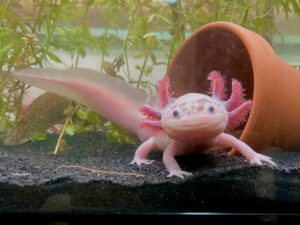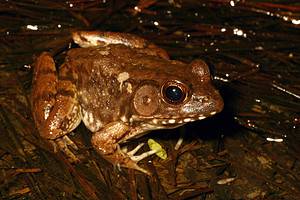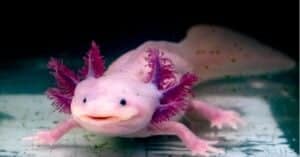All animals are either diurnal, nocturnal, or crepuscular, meaning they are primarily active either during the day, at night, or at dawn and dusk. But what about our favorite amphibians? Are frogs nocturnal? When do they hunt their food, mate, and socialize? Are there any diurnal frogs?
Whether you’re hoping to observe the frogs at your local park or in your backyard or perhaps you’re just curious, you’re in the right place! Read along as we explore when frogs are most active and the reasons why they prefer being awake during a certain time of day.
Are Frogs Nocturnal, Diurnal, or Crepuscular?
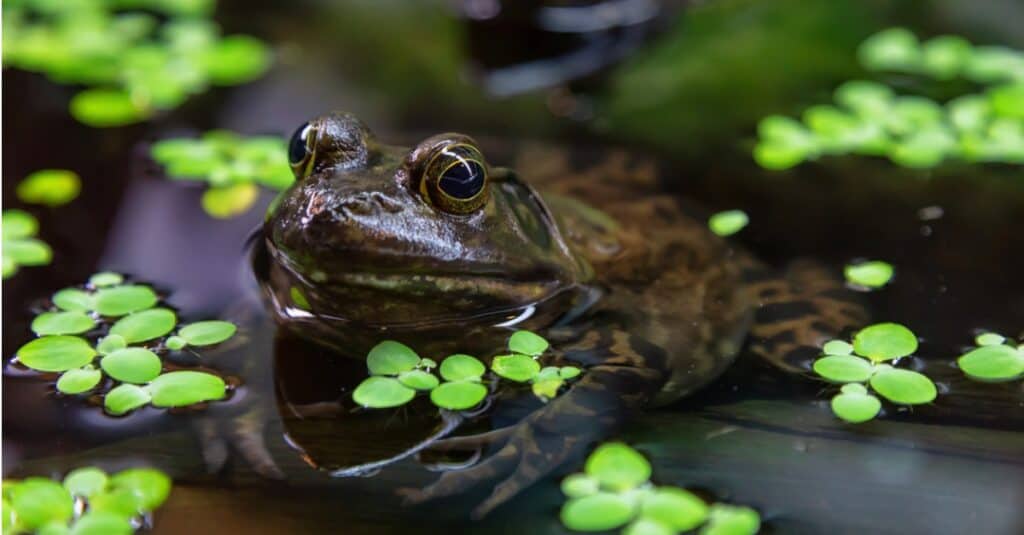
Most frogs, including common
bullfrogs
, are nocturnal.
©iStock.com/edb3_16
The vast majority of frog and toad species are either nocturnal or crepuscular. This means they tend to be most active at night or right around when the sun rises and sets. However, a select few species are diurnal, or active during the day! Generally, frogs with the ability to camouflage themselves are active at night and hide during the day. Brighter-colored frogs, such as poison dart frogs, are more likely to be diurnal.
The main determinant of whether a frog is nocturnal, crepuscular, or diurnal is the nature of its defense mechanisms. Frogs have two main defenses: camouflage to hide from predators or bright colorations and/or patterns to ward off predators.
Frogs that can camouflage themselves from predators prefer to find a spot to hide and rest in during the day. At night, they can safely come out and hunt, socialize, and search for mates. The majority of frog species use camouflage as their main defense mechanism, so they are mostly nocturnal or crepuscular.
A small group of frog species use bright colors and patterns instead of clever camouflage to defend themselves. Many of these species tend to be poisonous to predators, so their coloration serves as a warning to any animals looking to eat them! These frogs are usually diurnal so that predators can clearly see their warning colors in broad daylight and know to back off.
But this isn’t the only reason why most frogs are nocturnal! While their defense mechanisms play a large role in determining what time of day they are active, there are other factors at play here.
Other Reasons Why Most Frogs Are Nocturnal
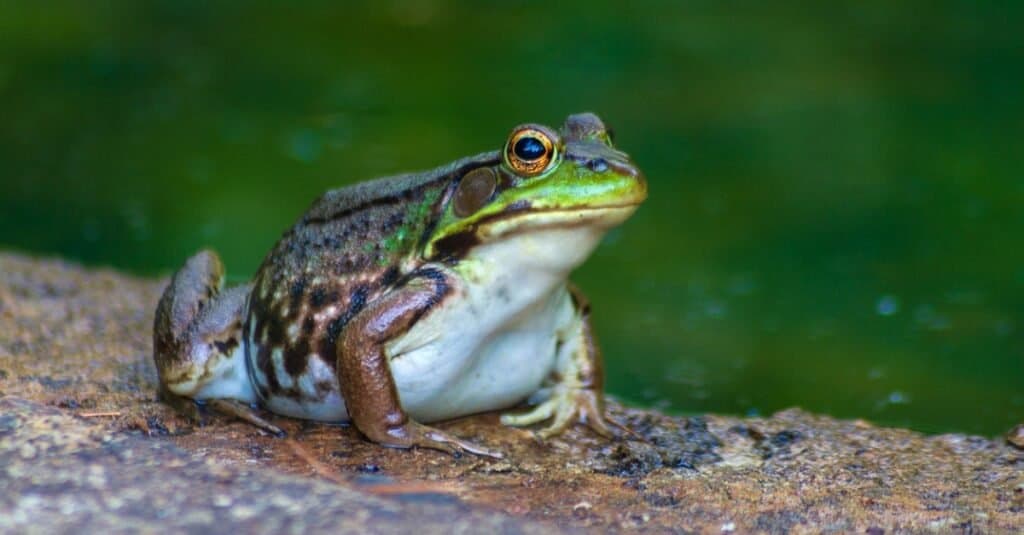
Frogs have excellent night vision.
©iStock.com/Corey T. Burns
Some other reasons why most species of frogs are active primarily at night or in the early morning and evening hours are:
- Increased humidity at night and at dawn/dusk
- Less interaction with diurnal predators
- Their vision is better suited to darkness
While brightly colored frogs can rely solely on their vibrant skin to ward off predators, camouflaging frogs have to be more creative. Since many of their predators are more active during the day, most frogs simply find a spot to blend in with their surroundings during the day and wait until night falls to hunt, mate, and socialize.
Additionally, humidity levels are usually higher at night and in the early morning and evening hours. Frogs have semi-permeable skin they are able to breathe with, but their skin must be moist to do so. With higher humidity levels, frogs are more willing to come out and be more active. During the day, in harsh sunlight, it is harder for them to find bodies of water and keep their skin wet.
Finally, frogs can see much better at night! Most species are far-sighted, meaning they can see things far away quite well but struggle with seeing small details close up. Fortunately, they have excellent night vision! Frogs can see a wide range of colors even in very low light conditions, while most of their predators can see better during the day. The various insects that frogs prey upon are also more active at night.
In short, it just makes sense for most frogs to hide and rest during the day and come out at night (or, for crepuscular frogs, during dawn and dusk). Their bodies are better suited for dimly lit, high-humidity conditions, and they are more able to find prey and evade predators at night.
What Time Do Frogs Come Out at Night?
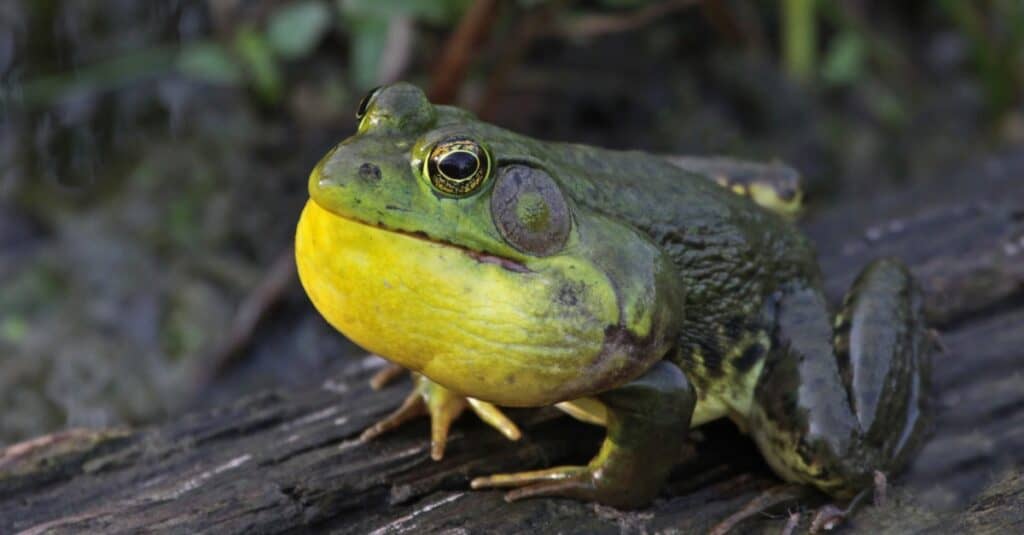
Frogs start to come out once the sun goes down and humidity goes up.
©iStock.com/ca2hill
If you’re hoping to observe frogs in the wild, most species are most active right after the sun sets until around 3:00 or 4:00 AM just before the sun rises. This is the best time for them to find prey and mates and evade potential predators.
As we touched on earlier, humidity levels tend to rise when the sun goes down. This increased humidity makes it easier for frogs to breathe, move, and eat, since they can breathe through their skin as long as they stay moist. Once the humidity begins to go up and the sun goes down, the frogs begin to come out! Listen closely for their noisy croaking–frogs are very vocal at night.
When the sun begins to rise, most frogs will return to their hiding spots until night falls once more. Once they find a spot to blend in, they will stay very still and silent for hours on end.
Why Are Some Frogs Diurnal?
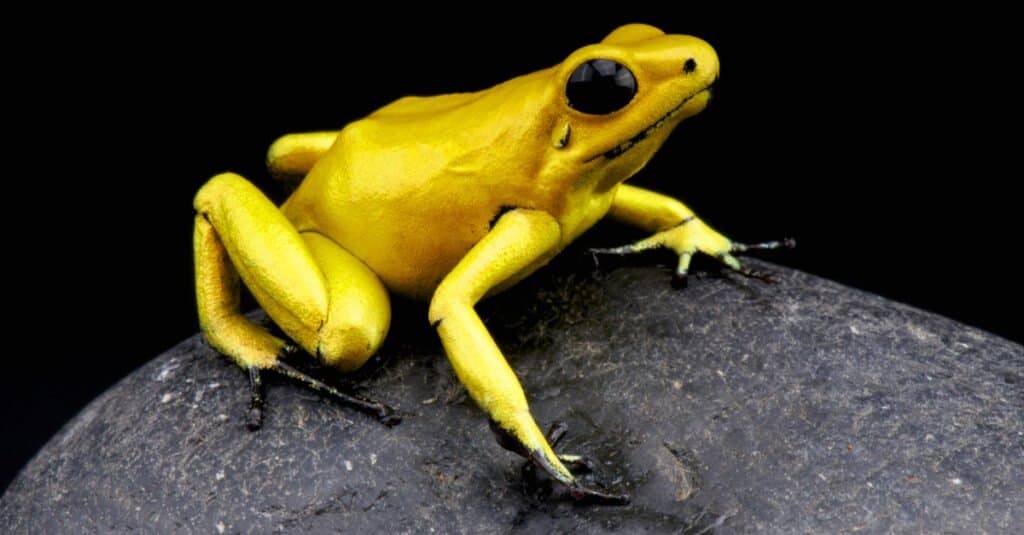
Poison dart frogs don’t need to camouflage themselves during the day to stay safe.
©reptiles4all/Shutterstock.com
Only a handful of frog species are diurnal. This mainly includes frogs within the Dendrobates and Phyllobates genus, such as the golden poison dart frog. These species have brightly-colored, toxic skin, which serves as their main defense mechanism. Since they don’t have to camouflage themselves to keep predators away, they can be more active during the day.
Not many frogs are diurnal–the vast majority of species use camouflage to stay safe and aren’t active until nightfall. However, frogs with poisonous skin aren’t particularly tasty to most predators, so they can hop about in broad daylight with little fear of being eaten. Their neon coloration also serves as a warning to remind even the most curious predators to back off!
Additionally, frogs within the Dendrobates and Phyllobates genus mostly live in very wet and warm tropical habitats throughout South America. Since the humidity stays consistently high in these densely forested areas, the unique frogs living there can keep their skin moist even in the middle of the afternoon when the sun is directly overhead.
The photo featured at the top of this post is © iStock.com/edb3_16
Thank you for reading! Have some feedback for us? Contact the AZ Animals editorial team.



